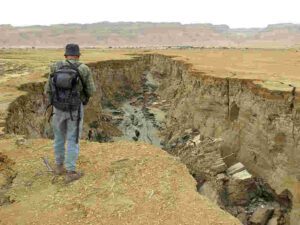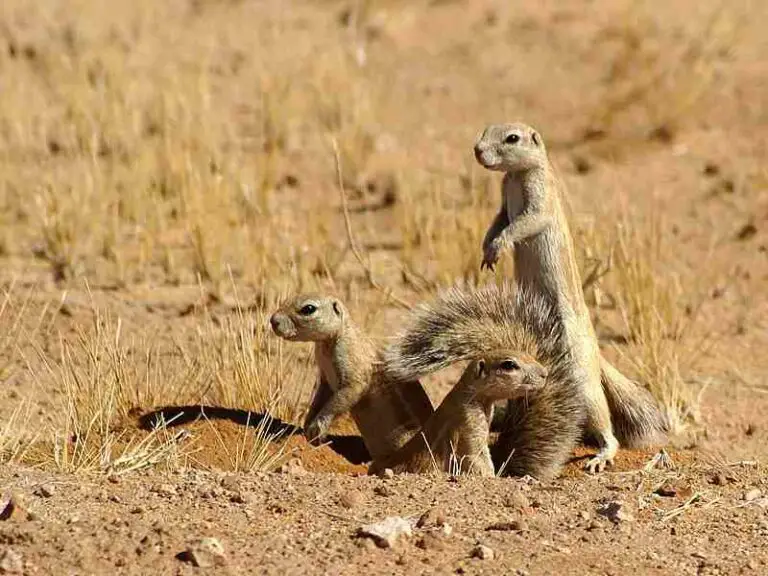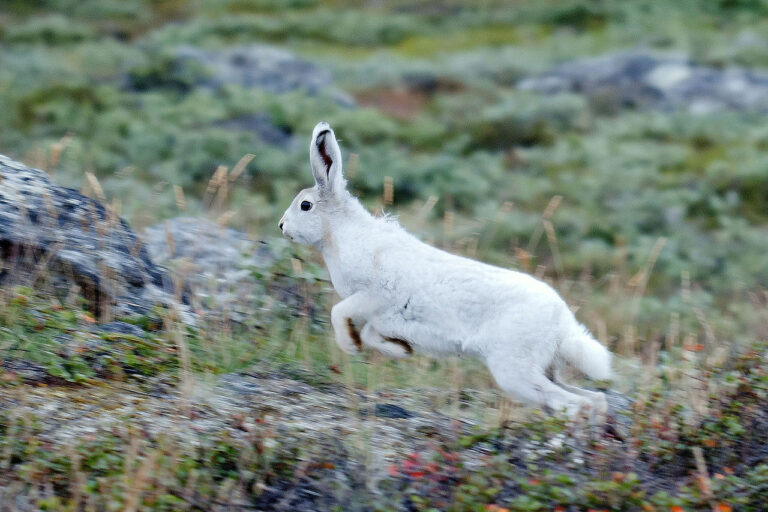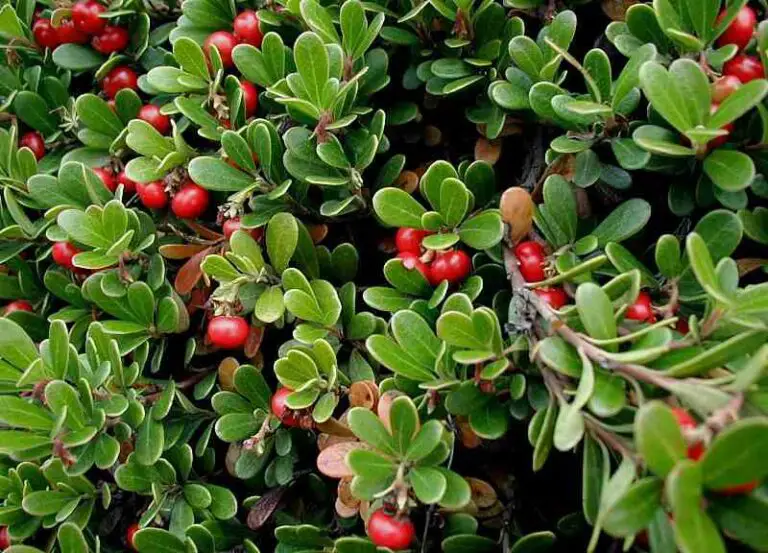11 Desertification Causes Explained (Natural and Manmade)
Desertification causes include; erosion, weather fluctuation, natural disaster, deforestation, climate change, overgrazing, overpopulation, irrigation, overpopulation, land use, urbanization and sociopolitical challenges.
These can be broadly classified into natural and anthropogenic categories. The causes of desertification are discussed in this article, as follows;
-Natural Causes of Desertification
1). Erosion as one of the Desertification Causes
When erosion is caused by naturally-induced wind and water currents, it can be considered to be an entirely-natural phenomenon.
Erosion of this kind can cause land degradation, when it leads to the removal of top soil and the leaching of important nutrients [9]. Erosion can negatively alter the equilibrium of the soil ecosystem as well as the structure and texture of soil.
Also, erosion is linked to some other factors and events that cause environmental degradation, such as unsustainable agriculture and flooding.
The type of desertification which can be single-handedly caused by erosion is mild/slight desertification.
This is because erosion alone may have relatively minor and temporary effects on the land or soil, which are unlikely to cause server desertification. However, when it occurs in combination with other natural and anthropogenic causes of deforestation, the effects may be severe.

2). Weather Fluctuation as one of the Desertification Causes
Natural variability in weather and climate can contribute to desertification [3].
The reason for this is that such changes can alter the physicochemical and biological characteristics of soil.
Most especially, erratic weather conditions involving irregular rainfall patterns and prolonged periods of dryness or non-rainfall, can degrade the soil and cause biological productivity to decline [6]. These effects are typical of desertification.
The role of natural weather fluctuation (erratic and heavy rainfall, drought) as a cause of desertification was more prominent in prehistoric times, as well as in centuries before the industrial revolution. Like erosion, natural weather fluctuation can only result in mild desertification.
3). Natural Disaster as one of the Desertification Causes
It could be argued that natural disaster is one of the most important causes of desertification, especially considering that desertification is a natural disaster itself [4].
Because natural disasters alter the equilibrium of the ecosystem, they may reduce biological productivity of soil, thereby leading to desertification.
Examples of natural disasters that can cause desertification include extreme weather events, wildfires and flooding. Each of these hazards can alter the physical and biochemical composition of soil, which is a condition for the occurrence of desertification.
-Anthropogenic Causes of Desertification
4). Deforestation as one of the Desertification Causes
Deforestation is simply a large-scale removal of vegetation.
It is one of the most prominent, anthropogenic causes of desertification. Land areas may be deforested for any of various reasons, such as agriculture, mineral exploration, human residential expansion, and biofuel demand.
When deforestation occurs, the land becomes vulnerable due to loss of vegetative cover [2]. Also, the internal structure of the soil becomes less-resilient as the roots of vegetation (which bind soil particles together) are removed.
These effects increase the risk of erosion, leaching, and nutrient/moisture loss, all of which lead to desertification.

5). Climate Change
Climate change is significant because it is related to several other causes of desertification.
Various anthropogenic factors and human activities may result in climate change. However, a compound term which can be used to describe most of these activities and factors is industrialization.
Mining, oil and gas exploration, energy development, electricity generation, waste disposal, incineration, and building construction are all examples of the potential causes of climate change.
An evidence of climate change is global warming, which is also a direct cause of desertification.
The term used to describe the process by which climate change and global warming may lead to desertification is aridification [5], which is a gradual and progressive change toward dry (arid) climatic and environmental conditions.
Increase in atmospheric temperature and changes in rainfall patterns, which may occur with climate change could alter soil moisture and nutrient composition, increasing the risk of desertification.
6). Overgrazing as one of the Desertification Causes
Overgrazing is one of a number of agriculture-related causes of desertification. It is also the main cause of desertification in pastoral lands [10].
When livestock are allowed to overgraze in any given area, the soil within that area soon loses its vegetative cover entirely. This increases the risk of environmental degradation, which may occur in the form of erosion, compaction, and leaching. Each of these forms of land degradation are potential precursors to desertification.
7). Irrigation as one of the Desertification Causes
Irrigation is another example of agriculture-related causes of desertification.
An unsustainable and improper approach to irrigation may involve the use of excessive quantities of water, or water with unsuitable physicochemical properties. The effects of such improper practices include sedimentation, salinization and waterlogging [8].
Each of these effects can reduce soil productivity and alter soil properties in an unfavorable way, thereby causing desertification.
8). Overpopulation and Resource Depletion as Desertification Causes
Population growth and large-scale migration are two major causes of overpopulation in regions of the world.
Overpopulation could be a cause of desertification [7], for any of various reasons.
One of these is the fact that population growth in any area is often accompanied by deforestation. This deforestation may cause desertification.
Also, overpopulation places a strain on environmental resources, such as water. Excessive usage and mismanagement of water and other resources can cause a decline in land productivity, thereby leading to desertification.
Other ways by which overpopulation can cause desertification, is through increase in the risk of unsustainable agricultural practices, and environmental degradation.
9). Inappropriate Land Use
Abrupt changes in land use, poor land use practices, and lack of proper environmental management are all aspects of inappropriate land use, which can be a cause of desertification.
Two examples of land use practices that contribute to desertification are heavy industrial practices and agriculture [1]. These can result in pollution and erosion, which are potential precursors to desertification.
10). Sociopolitical Challenges as one of the Desertification Causes
Some sociopolitical challenges are potential causes of desertification.
These challenges, such as political instability, economic recession, famine and food insecurity, may involve or lead to hazards or unsustainable environmental practices which could result in desertification.
11). Urbanization as one of the Desertification Causes
Urbanization is and land-use changes are closely related causes of desertification.
With urbanization, the uses of land areas change significantly. Industrial activities are usually more significant in urban areas, and deforestation is one of the processes involved in urbanization.
The demand for environmental resources may also increase, and environmental pollution may become more prominent. These activities and processes all increase the risk of desertification.
Conclusion
The causes of desertification are;
- Erosion
- Weather Fluctuation
- Natural Disaster
- Deforestation as one of the Causes of Desertification
- Climate Change
- Overgrazing
- Irrigation
- Overpopulation and Resource Depletion
- Inappropriate Land Use
- Sociopolitical Challenges
- Urbanization
References
1). Breckle, S.; Veste, M.; Wucherer, W. (2002). “Deserts, Land Use and Desertification.” Available at: https://doi.org/10.1007/978-3-642-59560-8_1. (Accessed 23 June 2022).
2). Emmanuel, O. (2017). “Effects of Deforestation on Land Degradation.” LAP LAMBERT Academic Publishing, ISBN: 978-3-330-34486-0. Available at: https://www.researchgate.net/publication/318921682_Effects_of_Deforestation_on_Land_Degradation. (Accessed 24 June 2022).
3). Henry, B. K.; McKeon, G.; Syktus, J. I.; Carter, J.; Day, K.; Rayner, D. (2007). “Climate Variability, Climate Change and Land Degradation.” Climate and Land Degradation (pp.205-221). Available at: https://doi.org/10.1007/978-3-540-72438-4_11. (Accessed 24 June 2022).
4). Kar, A. (2018). “Desertification – Causes and Effects. Chapter in Book: Exploring Natural Hazards – A Case Study Approach.” (Eds., D. Bartlett & R.P. Singh), CRC Press, Taylor & Francis, 2018. Available at: https://www.researchgate.net/publication/336281208_Desertification_-_Causes_and_Effects_Chapter_in_Book_Exploring_Natural_Hazards_-_A_Case_Study_Approach_Eds_D_Bartlett_RP_Singh_CRC_Press_Taylor_Francis_2018. (Accessed 24 June 2022).
5). Ma, Z.; Fu, C. (2007). “Global aridification in the second half of the 20th century and its relationship to large-scale climate background.” Science in China Series D Earth Sciences 50(5):776-788. Available at: https://doi.org/10.1007/s11430-007-0036-6. (Accessed 24 June 2022).
6). Mar, S.; Nomura, H.; Takahashi, Y.; Ogata, K.; Yabe, M. (2018). “Impact of Erratic Rainfall from Climate Change on Pulse Production Efficiency in Lower Myanmar.” Sustainability 10(2):402. Available at: https://doi.org/10.3390/su10020402. (Accessed 24 June 2022).
7). Mittal, R. (2013). “IMPACT OF POPULATION EXPLOSION ON ENVIRONMENT.” Available at: https://www.researchgate.net/publication/237771340_IMPACT_OF_POPULATION_EXPLOSION_ON_ENVIRONMENT. (Accessed 24 June 2022).
8). Singh, A. (2015). “Soil salinization and waterlogging: A threat to environment and agricultural sustainability.” Ecological Indicators 57:128. Available at: https://doi.org/10.1016/j.ecolind.2015.04.027. (Accessed 23 June 2022).
9). Trinh, M. .V. (2007). “Soil erosion and nitrogen leaching in northern Vietnam: expression and modelling.” Available at: https://www.researchgate.net/publication/40107634_Soil_erosion_and_nitrogen_leaching_in_northern_Vietnam_expression_and_modelling. (Accessed 24 June 2022).
10). Weber, K.; Horst, S. (2011). “Desertification and livestock grazing: The roles of sedentarization, mobility and rest.” Pastoralism Research Policy and Practice 1(1). Available at: https://doi.org/10.1186/2041-7136-1-19. (Accessed 24 June 2022).



